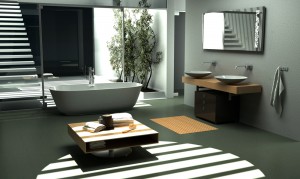 A spare bathroom in your basement area provides a boost in property value and an improvement to quality of life, but dealing with plumbing requires a host of special considerations.
A spare bathroom in your basement area provides a boost in property value and an improvement to quality of life, but dealing with plumbing requires a host of special considerations.
When you’re ready to take the remodeling plunge, here are a few guidelines to contemplate.
Check the depth of your sewer lines
If your basement is already plumbed for a washer and utility sink there’s a good chance that your drain lines are deep enough to easily add in an extra sink, toilet and shower.
If not, you may need to install an additional pump to properly dispose of wastewater and create enough “fall.”
Pro Tip: Be sure to double-check local building codes. Bathrooms below ground level must generally abide by a special set of regulations.
Measure pipe size
Particularly in an older home, sewer lines may be too narrow to handle an extra bathroom without augmenting the size of your pipes.
Replace drains with larger pipes if need be.
Plan to work around present infrastructure
Mapping out your new bathroom to align new fixtures with existing supply and drain lines can make a world of difference in labor and material costs when laying out the new pipe. The same goes for electrical wiring.
The better you can fit your scheme in with current infrastructure the sooner your project will be finished.
Consider a powder-room or ½ bath
Renovation costs escalate quickly with the addition of a tub or shower. Evaluate your needs honestly to determine how often the room will be used for bathing.
If the spare bathroom is meant to work in conjunction with a downstairs guest room, then go for it but if all you require is an extra toilet & sink you can save a lot of stress and money.
Don’t skimp on ventilation
The architect who originally designed your home probably didn’t plan for all that extra H2O in the basement. If you don’t extract the moisture properly, you could wind up with mold, mildew and water damage.
A heavy-duty extractor fan is an easy fix but be sure to purchase a large enough model. Ventilation fans are generally rated by how much air they can cycle through in an hour. Measure your room’s dimensions and shop accordingly.
Consider a pressure-assisted toilet
Talk to your plumber about whether a pressure-assisted toilet like the Kohler Highline Classic is needed to increase flush strength.
The added oomph can provide extra protection against clogs for basement toilets installed above shallow sewer lines. Even if your “fall” is sufficient on paper, the extra security will help keep the plunger at bay!
Try to work in natural lighting
Even below-ground basements are rarely 100% beneath grade. Consider installing glass blocks into the foundation wall or a small window to let natural light into the space.
